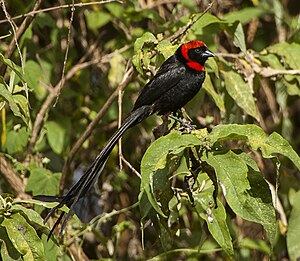Multiple sexual ornaments

Many species have multiple sexual ornaments, whereby females select mating partners using several cues instead of only one cue. Whereas this phenomenon is self-evident and hence long recognized, adaptive explanations of why females use several instead of only one signal have been formulated relatively recently. Several hypotheses exist, but mutually exclusive tests are still lacking.
Hypotheses[edit]
There are several hypotheses that attempt to explain why a male would have multiple sexual ornaments.
Multiple messages hypothesis[edit]
The multiple message hypothesis[2] states that different ornaments signal different properties of an individual's overall quality. Models support the possibility that this hypothesis is evolutionarily stable[3] but empirical tests are lacking.
Some ornaments represent long-term or short-term changes in overall condition. Elegant plumes in a bird or antlers in a deer grown once a year could signal the overall condition of an animal during the long period of growth; this is thus an example of a long-term change.[4] Secondary characters like the inflatable bare patches of skin on a grouse species or the colorful patches of skin in a primate species could represent short-term changes.[5]
Redundant signals hypothesis[edit]
The redundant signal hypothesis,[6] also known as back-up signal hypothesis,[7] states that each character can only best show partial representation of overall condition. If each ornament reflected the male's quality with a certain error, then mate choice based on a single trait would lead a female to select a male in poor condition rather than one in great condition. Thus, a female ought to look at multiple sexual traits of a male if she wants to get an overall view of the male's quality. The redundant signals hypothesis differs from the multiple messages hypothesis, as the latter predicts that different signals reflect the same aspect of mate quality, whereas the former predicts that different signals reflect different aspects.[8] There has been some empirical support of this hypothesis.[9] However, the majority of studies showed no correlation, suggesting the redundant signals are less common in indicating mate quality compare to other hypothesis like multiple messages hypothesis.[10][11][12]
Unreliable signals hypothesis[edit]
The unreliable signal hypothesis[2] suggests that some signals are unreliable indicators of overall male quality. Therefore, a female should look at multiple traits because one trait could be misleading. There is some support for this hypothesis.[13]
Sexual interference hypothesis[edit]
The sexual interference hypothesis[14] proposes that additional male signals evolve to hinder female mate choice by interfering with the propagation and reception of other males' sexual signals. Females respond by evolving the ability to glean meaningful information from signals despite males' attempts at obfuscation. In turn, males respond by improving their interference signals and producing new signals that are not so easily blocked. This iterative co-evolutionary process increases the costs of assessment for females and the costs of signal production for males, and leads to temporary equilibria of honest advertising via multiple signals.
References[edit]
- ^ Pryke, Sarah R. (2001). Sexual selection of multiple ornaments in the red-collared widowbird. Unpublished MSc thesis, University of Natal. Retrieved 7 August 2017.
- ^ a b Møller, A. P.; Pomiankoski, A. (1993). "Why have birds got multiple sexual ornaments?". Behavioral Ecology and Sociobiology. 32 (3): 167–176. doi:10.1007/bf00173774. S2CID 25591725.
- ^ Johnstone, Rufus A. (1996), "Multiple Displays in animal communication: 'backup signals' and 'multiple messages.'", Philosophical Transactions: Biological Sciences, 351 (1337): 329–338, doi:10.1098/rstb.1996.0026.
- ^ Moller, A. P.; Pomiankowski, Andrew (1993), "Why have birds got multiple sexual ornaments?", Behavioral Ecology and Sociobiology, 32 (3): 167–176, doi:10.1007/BF00173774, S2CID 25591725.
- ^ Changizi, Mark A.; Zhang, Qiong; Shimojo, Shinsuke (2006), "Bare skin, blood and the evolution of primate colour vision", Biology Letters, 2 (2): 217–221, doi:10.1098/rsbl.2006.0440, PMC 1618887, PMID 17148366.
- ^ Zuk, M.; Ligon, J. D.; Thornhill, R. (1992). "Effects of experimental manipulations of male secondary sex characters on mate preference in red jungle fowl". Animal Behaviour. 44: 999–1006. doi:10.1016/s0003-3472(05)80312-4. S2CID 53172540.
- ^ Candolin, Ulrika (2003). "The use of multiple cues in mate choice" (PDF). Biological Reviews. 78 (4): 575–595. doi:10.1017/s1464793103006158. hdl:1975/138. PMID 14700392. S2CID 8577794.
- ^ Candolin, Ulrika (2003). "The use of multiple cues in mate choice" (PDF). Biological Reviews. 78 (4): 575–595. doi:10.1017/s1464793103006158. hdl:1975/138. PMID 14700392. S2CID 8577794.
- ^ Jawor, Jodie M.; Breitwisch, Randall (2004), "Multiple Ornaments in male northern cardinals, Cardinalis Cardinalis, as indicators of condition", Ethology, 110 (2): 113–126, Bibcode:2004Ethol.110..113J, doi:10.1111/j.1439-0310.2003.00962.x.
- ^ BIRKHEAD, T. R., FLETCHER, F. & PELLATT, E. J (1998). "Sexual selection in the zebra finch Taeniopygia guttata : condition, sex traits and immune capacity". Behavioral Ecology and Sociobiology. 44 (3): 179–191. doi:10.1007/s002650050530. S2CID 28012906.
{{cite journal}}: CS1 maint: multiple names: authors list (link) - ^ ZUK, M., THORNHILL, R., LIGON, J. D., JOHNSON, K., USTAD, S., LIGON, S. H., THORNHILL, N. W. & COSTIN, C (1990). "The role of male ornaments and courtship behavior in female mate choice of red jungle fowl". American Naturalist. 136 (4): 459–473. doi:10.1086/285107. S2CID 84372337.
{{cite journal}}: CS1 maint: multiple names: authors list (link) - ^ Marchetti, Karen (1998). "The evolution of multiple male traits in the yellow-browed leaf warbler". Animal Behaviour. 55 (2): 361–376. doi:10.1006/anbe.1997.0586. PMID 9480704. S2CID 6223503.
- ^ Omland, K. E. (1996), "Female mallard mating preferences for multiple male ornaments", Behavioral Ecology and Sociobiology, 39 (6): 353–360, doi:10.1007/s002650050301, S2CID 1853483.
- ^ Lozano, G. A. (2009). "Multiple cues in mate selection: the sexual interference hypothesis". Bioscience Hypotheses. 2 (1): 37–42. doi:10.1016/j.bihy.2008.09.001.
External links[edit]
 Media related to Multiple sexual ornaments at Wikimedia Commons
Media related to Multiple sexual ornaments at Wikimedia Commons
